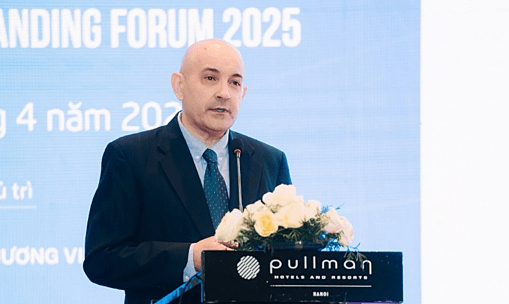RMIT academics emphasized the importance of adopting a resource-based approach, focusing on unique traits and resources that set businesses apart, rather than relying on cost advantages alone.
Many global brands have thrived by refining and leveraging their unique resources, such as local materials, traditional techniques, and entrepreneurial knowledge. Small businesses like Uruguay’s Black River Caviar and the U.K.’s Hawkshead Relish have gained international recognition through creativity, innovation, and the strategic use of natural resources and skills.
In Vietnam, where small and medium-sized enterprises account for over 95% of businesses, there is significant potential for similar paths of growth, said RMIT Associate Professor of International Business Abel D. Alonso. “Vietnam possesses unique traits that could drive international success without heavily relying on cost advantage strategies,” he said.
 |
Associate Professor Abel D. Alonso spoke at the 2025 Vietnam National Branding Forum on 16 April in Hanoi. Photo courtesy of RMIT |
During his address at the forum, Professor Alonso introduced the VRIN model—developed by American professor Jay Barney in 1991—which identifies four critical characteristics for competitive resources: valuable, rare, imperfectly imitable, and non-substitutable. A firm’s assets, attributes, knowledge, information, capabilities, and processes can be powerful resources if aligned with VRIN.
“This means firms have ‘many cards up their sleeves’ to stand out in the face of competition,” Associate Professor Alonso said.
 |
International certifications represent a key resource for Vietnamese exports. Photo courtesy of DACE |
Applying VRIN Model to Vietnam’s brands
Vietnamese businesses have started adopting VRIN principles, though there is room for more widespread application. For example, DACE, a local spice producer, has gained global competitiveness by aligning with VRIN, obtaining international certifications such as USDA Organic, JAS, and BioSuisse, and exporting its organic products worldwide. Similarly, Vietnam’s fashion industry has seen innovation, with companies like Viet Tien incorporating sustainable fibers like lotus and eucalyptus, distinguishing their products in the global market.
“Vietnam boasts a wide range of VRIN resources that are embedded in industries. Meanwhile, creativity, innovation, adaptability, and entrepreneurial flair are core to the country’s values,” said Alonso. He emphasized that companies that align with VRIN principles can build sustainable competitive advantages.
The demand for high-quality, eco-conscious products is rising in key export markets, creating new opportunities for Vietnamese brands. To capitalize on these trends, Alonso suggested that companies should communicate their value through relatable narratives, highlight successful small businesses, and activate their resource potential in line with VRIN principles.
“A balancing act must be considered, where the production of unique and VRIN-aligned products possesses a global appeal, has a constant supply and demand, and is complemented by personalised service,” Alonso noted.
 |
Experts joined the panel discussion at the Vietnam National Branding Forum 2025. Photo courtesy of RMIT |
Supporting innovation for sustainable growth
The theme of this year’s forum, “Breakthrough from Innovation and Creativity,” highlighted the role of innovation in enhancing competitiveness. “Innovation is vital for gaining global recognition,” said RMIT Senior Lecturer Dr. Oanh Vu.
“Technology plays a decisive role in transforming VRIN resources into competitive products and services. However, our research indicates that many Vietnamese companies still face challenges in adopting the necessary technologies for innovation.”Research conducted by RMIT’s team with 112 local business leaders revealed that external support is crucial for driving innovation. At the industry level, stronger business networks can foster unity, while government-level support through technological sponsorship, legal frameworks, and the development of a digital workforce can help local companies maintain their competitiveness.
“As global competition intensifies, Vietnamese businesses have a chance to define their edge through innovation,” Oanh emphasized. “With the right support and strategic mindset, Vietnamese companies can distinguish themselves by what makes them unique, not just by what makes them affordable.”




